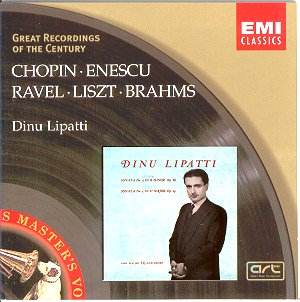Dinu Lipatti
CHOPIN Frédéric (1)
Sonata no.3 in b, op.58
LISZT Franz (2)
Années de Pélérinage: II. Italie: 5. Sonetto 104
del Petrarca
RAVEL Maurice (3)
Miroirs: 4. Alborada del Gracioso
BRAHMS Johannes (4)*
Walzer, op.39: 6, 15, 2, 1, 14, 10, 5, 6
ENESCU George (5)
Sonata no.3 in D, op.25
Recorded 1937 (4), 1943 (5), 1947 (1, 2),
1948 (3)
Dinu Lipatti (pianoforte) with Nadia Boulanger* (pianoforte).
EMI Great Recordings of the Century CDM 5 67566 2
Crotchet
£8.50 AmazonUK AmazonUS

The Chopin is one of the composer's richest works, but its teeming
counter-melodies and its profusion of contrasting ideas, not to speak of
its technical demands in a purely mechanical sense, often lead to confusion
and have discouraged frequent performance. No one has justified (indeed removed)
its complexities more than Lipatti. No one has found a more natural dialogue
in the first movement between the divine impetuousness of the primary material
and the melting loveliness of the secondary theme, and in the Largo
his long singing lines and his delicate accompanying figures converse freely
with one another. It seems a banal comment but when in the wild spin of the
finale heavy chordal writing is set against filigree passage-work it really
does seem impossible that only one person is playing.
The Liszt is deeply poetic while respecting the more extrovert character
of the composer and the duets with Nadia Boulanger must be some of the most
upbeat Brahms ever recorded, yet with no sacrifice of their deeply romantic
nature. A black mark to EMI here for, firstly, giving the whole set only
one track and, worse, for listing them numerically instead of in the order
in which they are played (the above is correct, with no.6 played both at
the beginning and at the end). Seldom has a fringe work like the Enescu had
a performance which has revealed such a range of colour and clarity of utterance
in it.
Bryce Morrison's excellent note does not mention that the Ravel was a single
take. At the end of a gruelling session, already exhausted (he was by then
fatally ill) Lipatti consented to play it just once. If anything went wrong,
he would not have the strength to repeat it. Dare I say that I find this
famous performance unduly demonic and uncharacteristically cavalier with
the dynamics? Gieseking may be fallible technically but his early-morning
insouciance is surely what the composer wanted, as well as delectable in
its own right.
About the recordings I have some worries. Comparison with an LP pressing
of the Chopin revealed a more defined bass line in the CD but a treble so
plummy that I felt I was experiencing the piano with cotton wool in my ears.
The LP had more distortion and was sometimes a little raw, but sounded closer
to a real piano. I don't want to put people off, because until I got out
my old LPs and started comparing I just listened enthralled, but the differences
are enough to alter one's perception of the pianist. I suppose it's a hopelessly
uncommercial suggestion, but when historical material is to be re-mastered
which is not yet so old as to have slipped entirely out of living memory,
could people not be brought in who could testify if the results correspond
to their memories of how the artist actually sounded?
Christopher Howell
Performances:

Recordings:


